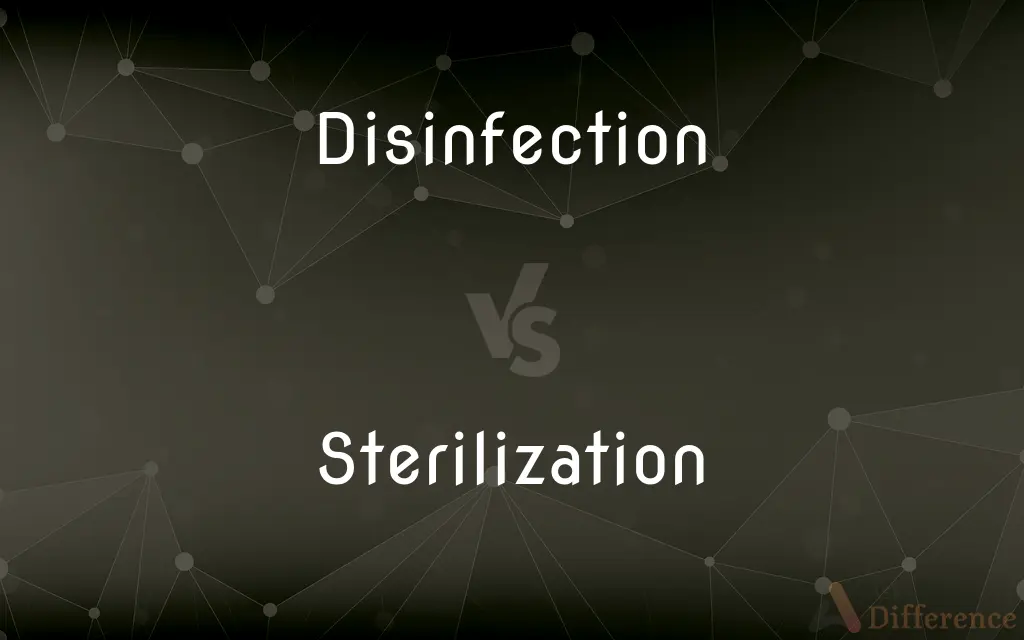Disinfection vs. Sterilization — What's the Difference?
Edited by Tayyaba Rehman — By Urooj Arif — Updated on March 20, 2024
Disinfection eliminates most pathogenic microorganisms except bacterial spores on surfaces or objects, while sterilization destroys all forms of microbial life, including spores, making an item completely microbe-free.

Difference Between Disinfection and Sterilization
Table of Contents
ADVERTISEMENT
Key Differences
Disinfection is a process that uses chemical agents, heat, or radiation to reduce the number of harmful microorganisms to a level where they are not able to cause disease, except for bacterial spores. It is often used for surfaces and medical equipment that do not require the absolute absence of all microbes. On the other hand, sterilization is a more intensive process that eliminates all forms of microbial life, including bacteria, viruses, fungi, and spores. This process is crucial for surgical instruments, certain laboratory equipment, and items that will be introduced directly into the human body.
While disinfection can be achieved through various methods such as using bleach, alcohol, or boiling water for a certain period, sterilization requires more rigorous methods like autoclaving (steam under pressure), dry heat, or chemical sterilants. The choice between disinfection and sterilization depends on the intended use of the item and the level of microbial cleanliness required.
Disinfection is suitable for items that come into contact with skin but not mucous membranes. It is a common practice in households, schools, and non-surgical medical settings. Sterilization, however, is reserved for items that enter sterile areas of the body, such as the bloodstream or internal tissues. This distinction is crucial in healthcare settings to prevent infections.
The effectiveness of disinfection is influenced by factors such as the presence of organic matter, the type of microorganisms present, and the concentration and contact time of the disinfectant. In contrast, sterilization conditions are strictly controlled to ensure the complete elimination of all microbial life.
Disinfection and sterilization are both critical components of infection control practices, but their application varies based on the level of microbial control required. While disinfection reduces the risk of infection by lowering the number of pathogens, sterilization provides the highest level of microbial security by removing all potential sources of infection.
ADVERTISEMENT
Comparison Chart
Goal
Reduce pathogenic microorganisms to safe levels
Eliminate all forms of microbial life
Microbial Targets
Most bacteria, viruses, and fungi; not spores
All microorganisms, including spores
Methods
Chemicals (e.g., bleach, alcohol), heat, radiation
Autoclaving, dry heat, chemical sterilants, radiation
Application
Surfaces, non-invasive medical equipment
Surgical instruments, items entering sterile body areas
Effectiveness Factors
Organic matter, type of microorganisms, contact time
Controlled conditions, method efficacy
Compare with Definitions
Disinfection
Application of heat or radiation for non-surgical cleanliness.
Boiling baby bottles for disinfection.
Sterilization
Achieves highest level of microbial cleanliness.
Sterilization of laboratory culture media.
Disinfection
A process to eliminate most pathogenic microorganisms, excluding spores.
Using bleach solution for disinfecting countertops.
Sterilization
Involves methods like dry heat and chemical sterilants.
Using ethylene oxide gas for sterilizing medical devices.
Disinfection
Targeted for surfaces or objects that contact skin.
Disinfecting gym equipment between uses.
Sterilization
Complete elimination of all microbial life, including spores.
Autoclaving surgical instruments before use.
Disinfection
Involves procedures to lower the risk of infection.
Disinfecting a wound with alcohol.
Sterilization
Required for items entering sterile areas of the body.
Sterilizing needles for injections.
Disinfection
Use of chemical agents to reduce microbe levels to safe levels.
Disinfecting a bathroom with a phenolic solution.
Sterilization
Practices aimed at preventing all potential infections.
Steam sterilization of dental tools.
Disinfection
The process of cleaning something, especially with a chemical, in order to destroy bacteria
Instruments must undergo high-level disinfection before reuse
Sterilization
The process of making something free from bacteria or other living microorganisms
The food processing plant has undergone three sterilizations supervised by a microbiologist
Disinfection and sterilization of surgical equipment
Disinfection
To cleanse so as to destroy or prevent the growth of disease-carrying microorganisms
Disinfect a hospital room.
Sterilization
Surgery to make a person or animal unable to produce offspring
She had three children and had undergone sterilization
In the years preceding the case, the number of sterilizations performed there rose dramatically
Disinfection
Treatment with disinfectant materials in order to destroy harmful microorganisms
Sterilization
To make free from live bacteria or other microorganisms.
Disinfection
The act of disinfecting; purification from infecting matter.
Sterilization
To eliminate the ability of a person or animal to produce offspring, as by altering or removing the reproductive organs.
Disinfection
Treatment to destroy harmful microorganisms
Sterilization
To make incapable of bearing fruit or germinating.
Sterilization
To render (land) unfruitful.
Sterilization
(Economics) To place (gold) in safekeeping so as not to affect the supply of money or credit.
Sterilization
To make inoffensive or innocuous
Sterilized the terminology with euphemisms.
Sterilization
(uncountable) A procedure to permanently prevent an organism from reproducing.
Spaying a cat is a form of sterilization to limit the population growth.
Sterilization
(countable) An instance of a sterilization procedure.
The vet performed several sterilizations this week.
Sterilization
(uncountable) A monetary policy operation used to offset a foreign exchange intervention.
The Federal Reserve is responsible for foreign exchange sterilization.
Sterilization
The act or process of sterilizing, or rendering sterile; also, the state of being sterile.
Sterilization
The act of making an organism barren or infertile (unable to reproduce)
Sterilization
The procedure of making some object free of live bacteria or other microorganisms (usually by heat or chemical means)
Common Curiosities
Can disinfection replace sterilization in medical settings?
No, disinfection cannot replace sterilization in situations where absolute microbial elimination is required, such as with surgical instruments.
What is disinfection?
Disinfection is the process of eliminating most pathogenic microorganisms, except spores, on surfaces or objects to reduce infection risk.
What is sterilization?
Sterilization is the complete destruction of all forms of microbial life, including bacteria, viruses, fungi, and spores, to achieve a microbe-free state.
How do disinfection and sterilization differ in their goals?
Disinfection aims to reduce pathogens to safe levels, while sterilization aims to eliminate all microbial life for the highest level of cleanliness.
What ensures the effectiveness of sterilization?
Effectiveness is ensured by controlled conditions and the proper application of sterilization methods.
Can sterilization be achieved with alcohol?
No, alcohol is a disinfectant and does not achieve the complete elimination of all microbial life, including spores.
What are common methods of disinfection?
Common methods include the use of chemical disinfectants like bleach and alcohol, as well as heat and radiation.
What are common methods of sterilization?
Methods include autoclaving, dry heat, chemical sterilants, and radiation, each chosen based on the item's material and tolerance.
Why is sterilization important in healthcare?
Sterilization is crucial to prevent healthcare-associated infections, especially during surgeries or when instruments contact sterile body parts.
Where is disinfection commonly used?
Disinfection is used on surfaces, in households, schools, and for non-invasive medical equipment.
Where is sterilization required?
Sterilization is required for surgical and certain medical instruments, and items that will be in contact with sterile body areas.
What factors affect the effectiveness of disinfection?
Factors include the presence of organic matter, type of microorganisms, and the disinfectant's concentration and contact time.
How do disinfection and sterilization contribute to infection control?
Both processes are key to infection control, with disinfection reducing the risk of infection by lowering pathogen levels and sterilization eliminating all potential sources of infection.
What is the significance of sterilizing surgical instruments?
It prevents the transmission of infections to patients, ensuring their safety during invasive procedures.
Share Your Discovery

Previous Comparison
Analyze vs. Investigate
Next Comparison
Hex vs. CurseAuthor Spotlight
Written by
Urooj ArifUrooj is a skilled content writer at Ask Difference, known for her exceptional ability to simplify complex topics into engaging and informative content. With a passion for research and a flair for clear, concise writing, she consistently delivers articles that resonate with our diverse audience.
Edited by
Tayyaba RehmanTayyaba Rehman is a distinguished writer, currently serving as a primary contributor to askdifference.com. As a researcher in semantics and etymology, Tayyaba's passion for the complexity of languages and their distinctions has found a perfect home on the platform. Tayyaba delves into the intricacies of language, distinguishing between commonly confused words and phrases, thereby providing clarity for readers worldwide.
















































